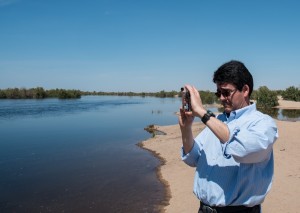Annie Snider left an excellent summary in our Christmas stocking of the state of play on the Colorado River. Lake Mead approaches the end of the Calendar year at elevation 1,087 feet above sea level, which is nearly 20 feet below last year at this time, as basin water managers scramble to build new institutional widgets aimed at propping up the lake’s level against looming shortage declarations. A deal signed this month takes the next step:
All sides agree that the deal, signed during the users’ conference here, won’t begin to solve the basin’s overarching problems. For one thing, users have only mapped out the path to 750,000 acre-feet of those reductions and are back-weighting the targets.
But it does suggest states are prepared to share the pain rather than battle over the remaining water in court.
It also follows an earlier agreement among water users in the Lower Basin this summer to conduct an $11 million conservation pilot program (Greenwire, Aug. 1).
“I think the significance of the system conservation agreement isn’t the volume of water; it isn’t the amount of money; it’s not even the parties who are there,” said John Entsminger, general manager of the Southern Nevada Water Authority.
“It’s the fact that for the first time on the river, we see major water users acting with the basin as a whole in mind and getting to that equilibrium and treating the system as the beneficiary rather than acting in their own local best interest and trying to put water in their bank accounts.”

Deputy Interior Secretary Mike Connor at the San Luis Bridge, March 28, 2014, watching the delta pulse flow
Michael Connor, the Interior Department’s second in command, who helmed Reclamation for more than four years, had tough words for his former colleagues in the basin.
If conditions worsen without consensus from the states on what to do, the federal government will have to step in, he told them at the conference.
“We need more urgency, more definitive commitments and more collaborative agreements,” he said. “Without proactive agreements, I fear the Colorado River Basin will return to its past and replicate what still goes on in many basins, which is conflict, litigation and gridlock.”
The entire piece, which seems to be out from behind the E&E paywall, is worth reading.
